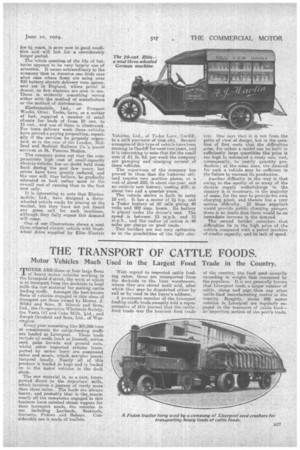THE TRANSPORT OF CATTLE FOODS.
Page 23

If you've noticed an error in this article please click here to report it so we can fix it.
Motor Vehicles Much Used in the Largest Food Trade in the Country.
MHERE ARE three or four large fleets
of heavy motor vehicles working in the Liverpool d:strict, the work of which is to transport from the dockside te local mills the raw material for making cattle feeding stuffs. Amongst the best-known fleets of vehicles engaged in this class of transport are those owned by Messrs. J. Bibby and Sons, R. Silcisek and Sons, Ltd., the Co-operative Wholesale Society, the Vesta Oil and Cake Mills. ;tele and Joseph Orosfield and Suns, Ltd., of Warrington.
• Every year something like 800,000 tons of constituents for cattle-feeding stuffs are landed at Liverpool. . These loads include oil seeds (such as linseed), cotton seed, palm kernels and ground nuts, whilst other imported articles transported by motor lorry are compound cakes and meals, which areealso manufactured locally. Nearly all of this produce is landed in bags and is leaded on to the motor vehicles in the dock The raw material is, as a rule, transported direct to the importers' mills, which involves a journey of rarely more than three miles. The loads are always heavy, and probably that is the, reason nearly all the companies engaged in this business have select-eel steam wagons for their transport needs, the vehicles. in use inchiding Loylands, Sentinels, Garretts, Fotlens and Robeys. Considerable use is made of trailers. With regard to imported cattle feeding cakes, these are transported from the dockside to the local warehouses, where they ,are stored until sold, after which they may be diepatched either by rail or by road to the buyer's address.
A prominent, member of the Liverpool feeding-stuffs trade recently told a representative of this journal that the cattlefood trade wag the heaviest food trade of the country, the food used annually exceeding in weight that consumed by the populace. It is not generally known that Liverpool feeds a larger number of cattle, sheep and pigs than any other cattle-food manufacturing centre, in the country. Roughly, about 200 motor vehicles in Liverpool are regularly engaged in the transport of cattle food— an important section of the port's trade.
































